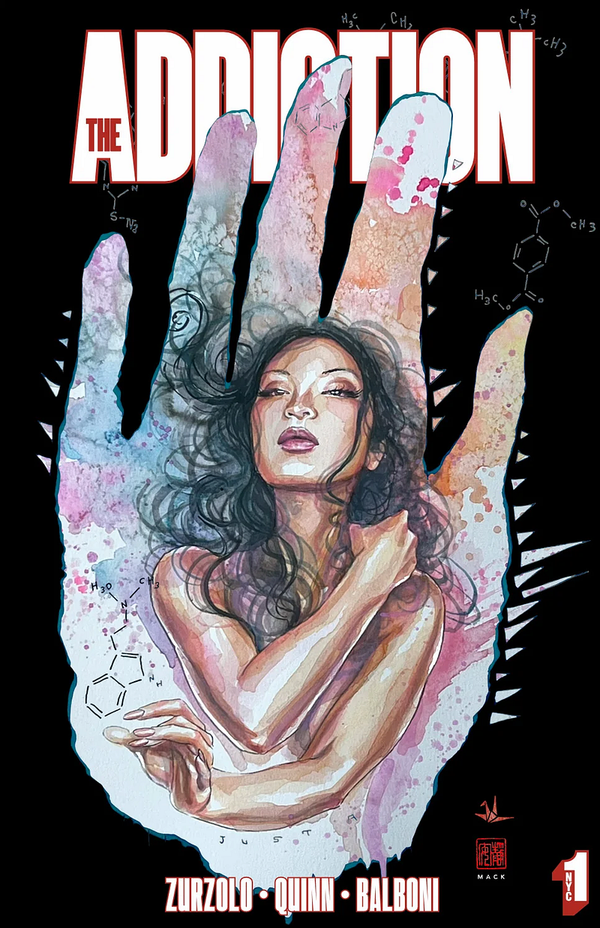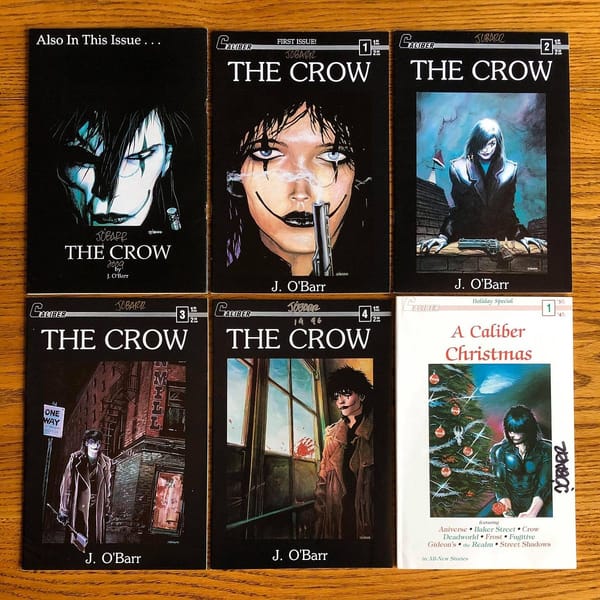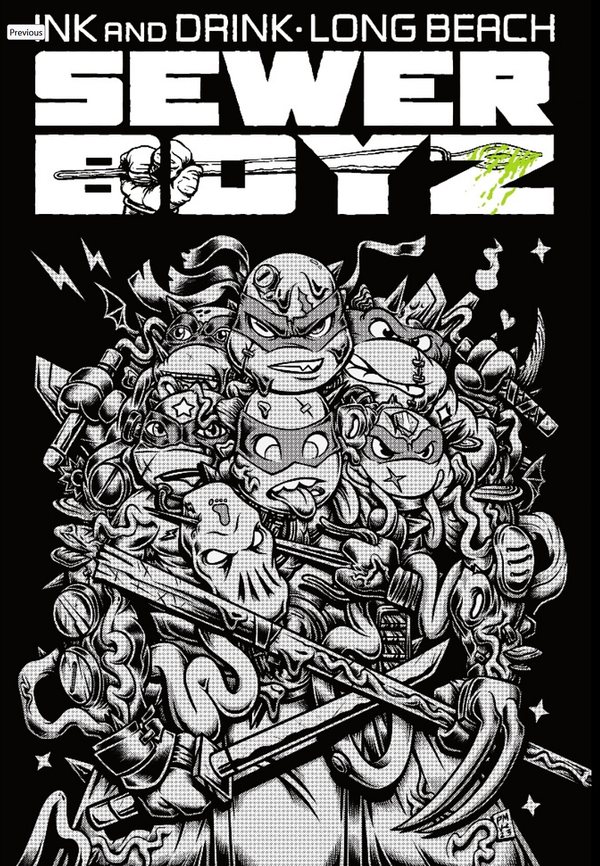After The Crow: The Works of James O’Barr Part 3
Since completing the origin The Crow series in 1992, O’Barr has published only a few things in fits and starts. Here’s what he’s been up…
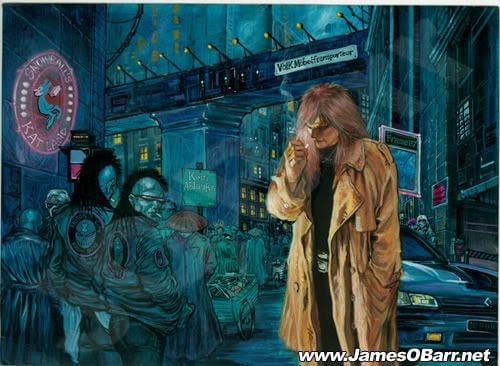
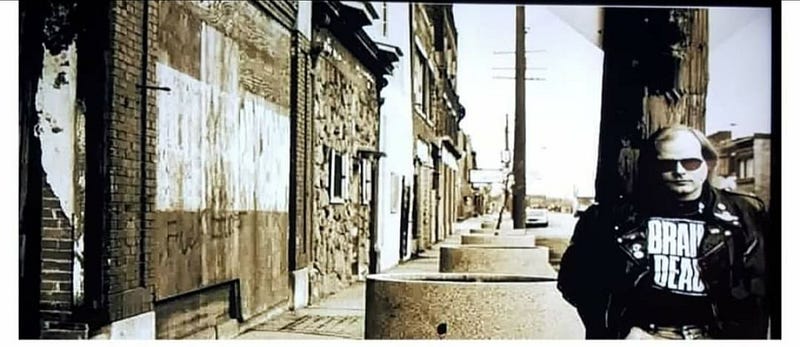
Special thanks to John Ekleberry and his website The James O’Barr Collector and John Bergin and his Instagram account.
- Part 1: The Crow Creator James O’Barr’s Early Years
- Part 2: The Crow and Caliber Years
- Part 3: After The Crow: The Later Works of James O’Barr
Note: I might receive a cut of any referrals to Mycomicshop.com.
1992 proved to be O’Barr’s second most prolific year in terms of finished pages published. Most importantly, he finished The Crow, with the long-awaited finale finally shipping in May 1992 from Tundra — Teenage Mutant Ninja Turtles co-creator Kevin Eastman’s publishing company. That year also saw the release of O’Barr’s “Slave Cylinder” in the pages of Bone Saw from Tundra, a glimpse of Gothik, and the curious “Zeitgeist.”
Unfortunately, the prolificity didn’t last. Though he’s continued to paint covers and write (and even layout) the occasional sequel book to The Crow, O’Barr has published relatively little new finished sequential art since Brandon Lee’s death on the set of The Crow film in March 1993. He’s been open about his struggles with addiction following the tragedy. (“After Brandon died, I needed to self-medicate, I was a junkie for six years,” he told the Panel Borders podcast in 2014.)
His mental health and Hollywood commitments, such as publicity for the first film and negotiations for the sequels, would explain his long absence. But the few things that have been released — such as The Ride: Inertia’s Kiss and the Sundown app — show that he hasn’t been idle. I’m not sure I believe it, but he has said that he completed 300 pages of Gothik, his great unfinished cyberpunk saga that he began in 1990 (or in 1988, if you count “IO” from Caliber Presents as part of the story) before abandoning it. He has also continued to draw and paint covers for books, comics, and albums, and work the convention circuit selling sketches and doing commissions.
He’s amassed a fairly large body of work, but only some of it has been published and much of it is in the hands of private collectors. Let’s take a look at what’s bubbled to the surface.
Bone Saw
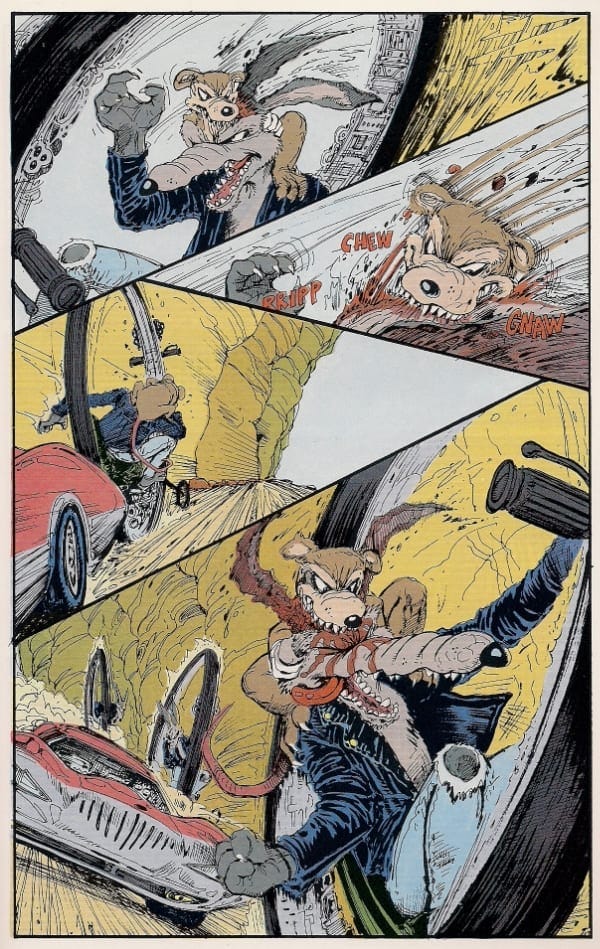
Bone Saw was an anthology edited by O’Barr and John Bergin featuring poetry, prose, comics, collage, and sculpture, mostly in a post-apocalyptic/industrial-horror vein. Advertisements said it would hit the stands in January, 1992 but it might have shipped later.
O’Barr’s primary contribution, “Slave Cylinder” — adapted from a short story by Jeff Holland that is also included in the anthology — is one of O’Barr’s most significant works and, at 32 pages, it’s the longest non-Crow thing he’s published thus far. The piece, colored by Carolyn Bergin, is the only color section in the book, and some of O’Barr’s only sequential work published in color.
“Slave Cylinder” is also a bit of an outlier both within Bonesaw and in O’Barr’s bibliography. Although many of the anthology’s pieces have a sense of humor, “Slave Cylinder” is an all-out slapstick Knight Rider meets Wile E. Coyote cyberpunk pastiche. The story, such that it is, mostly revolves around a guy named Henry (remember that name!) in his talking Plymouth Roadrunner, fleeing a gang of “coyotes” on weird circular motorcycles. A pack of talking rats in the backseat provide commentary and sometimes assistance. Still, it features many of his obsessions: muscle cars, opiates, glam-goth guys, and references to both Big Black and Joy Division. It might also take place in the same shared cyberpunk universe as Gothik/Golgothika/Wednesday: the “coyote” motorcycles also appear in Wednesday and Wednesday’s robot monkeys remind me of Henry’s rats.
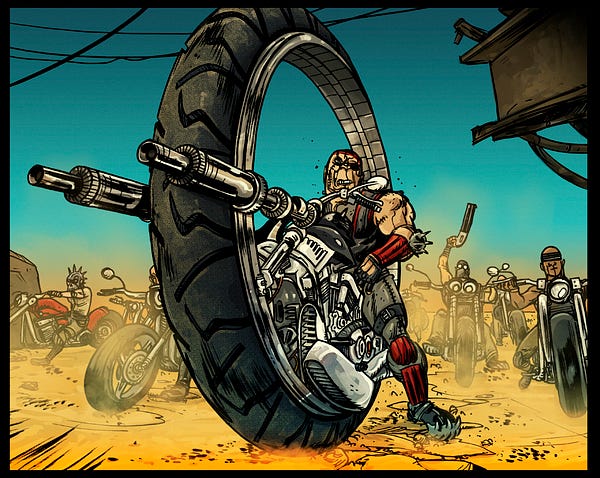
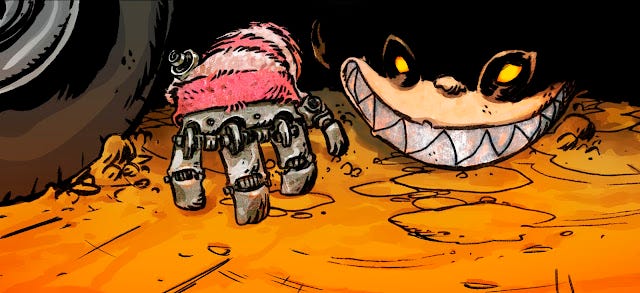
Bone Saw also features two short collaborations between Bergin and O’Barr: “German Film, Blurred” and “Recoil,” which are part of the “Morphine Dreams” series the duo began in the pages of Bergin’s Caliber Comics anthology Ashes. Basically, O’Barr sent postcards describing dreams to Bergin, who adapted them into comics form. The book also includes photos of several sculptures by the late great Rene J. Cigler, an homage to Joel-Peter Witkin by Bergin (well before Nine Inch Nails’s “Closer” video), a flash fiction piece by Lawrence Watt-Evans, two short comics by Michael Manning, and much more.
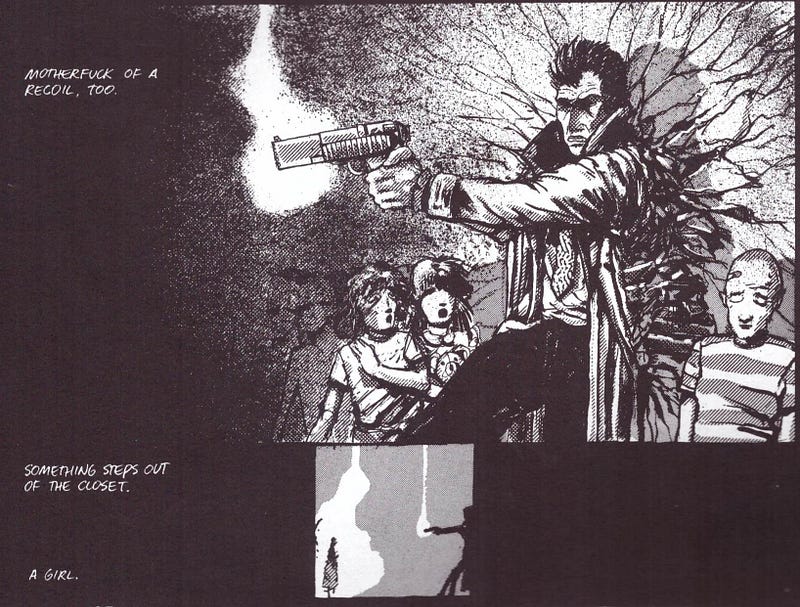
Bone Saw was apparently of particular interest to Eastman, who cited it as a favorite in an epic interview with The Comics Journal in 1998 about Tundra. Eastman poured millions of dollars of his own money into Tundra before — and even after — the company merged with Denis Kitchen’s publishing venture Kitchen Sink Press in the summer of 1993. In the interview, Eastman said:
A lot of Tundra projects stayed but only a very few became profitable under the Kitchen Sink imprint, to all our frustration. And again, separately the big money losers that I wanted finished were completed. I personally funded the ones I knew would never make money, like the collection of Rain. John Bergin’s Bone Saw. Denis was like, “Send it back to John. I don’t want it.” And I said, “No, I carried it through this far, and I want to see it done as a collection. And I’ll pay for it.”
Given that Bone Saw was published under the Tundra banner before the company merged with Kitchen Sink, it’s possible that Eastman was actually referring to Bergin’s graphic novel From Inside, published with the Kitchen Sink logo in 1993. Sadly, neither Bone Saw nor From Inside remained in print from Kitchen Sink or any other publisher. They’re not too hard to find second-hand, however. Also, “Slave Cylinder” was reprinted in black and white in Pink Dust and The Ride: Inertia’s Kiss Sketchbook, and “German Film Blurred” was reprinted in Bergin’s retrospective anthology Dust.
Bone Saw has the feel of being a prestige, special edition of Ashes or Bergin’s zine Brain Dead. “The last issue of Brain Dead was published in 1990, but I wasn’t quite finished with making anthologies then,” Bergin wrote on Instagram. “We’d always hoped to make more issues [of Bone Saw].” Instead, the single volume ended up being sort of a capstone to those projects. It also served as a declaration of the direction Bergin and O’Barr planned to head next.
Gothik
O’Barr’s big follow-up to The Crow was supposed to be a cyberpunk series eventually known as Gothik. The idea was to serialize the story alongside Bergin’s own cyberpunk series “Golgothika” in a series from Dark Horse Comics. The title of O’Barr’s part of the story and the anthology went through several iterations, including Chinese Bones, Black Glass, and Black Chrome before settling on Gothik. Only two excerpts of O’Barr’s contribution to Gothik were ever published, but Bergin eventually published four issues of a stand-alone Golgothika with Caliber in 1996 and 1997.
“James and I had planned to have characters, settings, and plot developments overlap and cross-over,” Bergin wrote in Golgothika # 3, published in 1997. “We were working on the project for Dark Horse Comics. To make a long story short: The first two installments of Golgothika were completed, Gothik was canceled (for various reasons) and the editor for the book left Dark Horse. As a result there was no longer anyone at Dark Horse interested in supporting the Golgothika/Gothik project. They were kind enough to return my work. I brought it to Caliber Comics and am quite pleased to be here.” Unfortunately, that iteration of Caliber was in the process of shuttering. Golgothika was canceled after four issues, leaving a completed fifth issue unpublished.
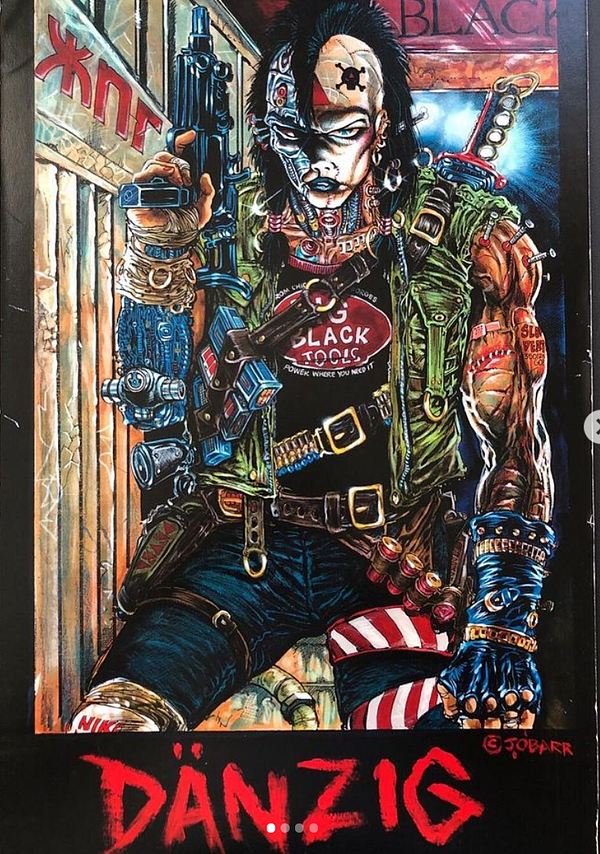


The origins of Gothik date back to around 1990 when Bergin and O’Barr were approached about doing a graphic novel adaption of Neuromancer by William Gibson. Ultimately, Bergin and O’Barr decided to do their own cyberpunk comic. Both Gothik and Golgothika featured Blixa Danzig, the cyborg mercenary first introduced in “IO” in the pages of Caliber Presents in 1989. The earliest mention of the project I can find is from Terra X magazine in 1991: “For Tundra U.S. I’m doing a fully painted six issue series called CHINESE BONES, a kind of cyberpunk car crash between Wizard of Oz and Blade Runner.”

Readers got their first look at Gothik in the four-page black and white story “Frame 137,” first published in Storming the Reality Studio in 1991 and then republished in Dark Horse Presents # 61, cover-dated April 1992. The story portrayed a somewhat androgynous protagonist named Jonny Z (O’Barr’s pen name for his work on Deadworld and Silverfawn was “Jonny Zero”) assassinating a pimp. “Frame 137” wasn’t billed at the time as part of a larger story, though it certainly hinted at a larger world.
The Gothik project moved from Tundra to Dark Horse sometime between 1992 and 1994. In The Boston Herald’s 1994 story on O’Barr, the paper reported that “‘Gothik,’ a preview to the epic ‘Chinese Bones,’ published by Dark Horse Comics, will make its debut at the annual San Diego Comic Convention this summer”:
“I hope I don’t alienate readers, if that’s possible, with this book,” [O’Barr] said.
Issues of child abuse, drug addiction and violence will dominate the book, he said, issues that continue to play a role in his life — and influence his darkly innovative and unique work.
There was a one-page pin-up of Blixa Danzig published in Dark Horse’s San Diego Comic-Con Comics #2 in 1993, but Dark Horse never published another “Gothik” preview at San Diego or anywhere else.
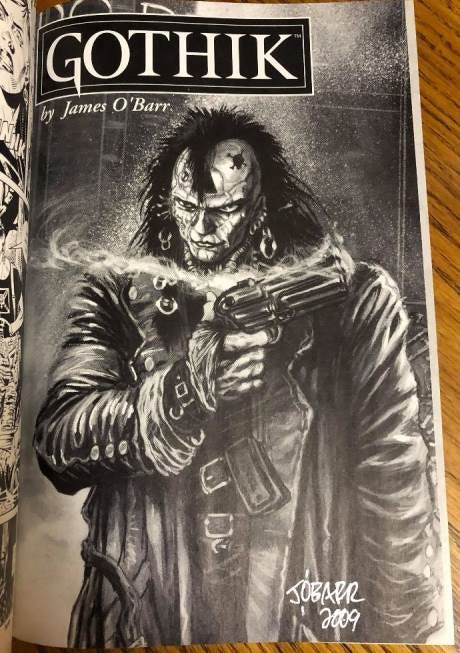
The only other glimpse of “Gothik” most fans ever got was “Snake Dance” in Monster Massacre Special from Black Ball Comics (a company started by former Tundra UK publisher Dave Elliott), also in the summer of 1993. The full-color 14-page story depicts Blixa trying to break into a building, only to be confronted by a bio-engineered dragon. It also introduces Blixa’s sidekick Gracie. According to Bergin, this story was meant to bridge Gothika and Golgothika.
A few very lucky people also got their hands on a Gothik pitch bible. I’ve only seen photos of a few pages of this: a full-color page of art, an excerpt from the script, and a pitch for the series. According to the pitch, the story was set in Detroit in the then far-off year of 2019, described as a feral city abandoned by the state and “Vegas on LSD.” The plot would revolve around “John Henry,” known as Jonny Zero, searching Detroit for his lost sister, Kay (who is also mentioned in “Frame 137”). I don’t think this means that Henry from “Slave Cylinder” is supposed to be Jonny Z, but Henry will come up again later. [If anyone has a copy of this pitch bible for sale, please get in touch!]

Apart from the sketchbook, the most detailed description of Gothik was in Dike Blair’s 1994 interview with O’Barr:
The new book I’m doing is called Gothik. I showed the drawings to Ed Pressman and Jeff Most, who did The Crow, and they pretty much bought it on the spot. So, I’m working on the screenplay at the same time I’m doing the book. It looks like this might be a pretty big budget film — they’re talking to Ridley Scott who I’d love to see do it. It deals with Detroit street gangs about 20 years in the future. I wanted to keep the poetry and lyricism that’s in The Crow; so, I’m mixing poetry with a street language that is part Chinese, part Russian, and part American. My main character is a drug addict who nods outs and has mystical dreams in which he visits a cathedral where he has deep philosophical discussions with three gargoyles. He has to coax the gargoyles on by feeding them cats. It’s pretty bizarre and pretty funny at the same time.
Fangoria provided some other details, and reported a move from Dark Horse to Kitchen Sink, in 1996:
Besides doing a Crow lithograph with the proceeds going to the Bruce Lee Foundation, O’Barr is also working on a promisingly frightening non-Crow comic-book project, a 12-issue miniseries called Gothik, due from Kitchen Sink in early *97. “It’s basically Blade Runner meets The Wizard of Oz pumped full of drugs with the volume turned up loud,” he laughs. “It’s set in a decayed urban future and deals with the Asians and the Germans fighting for control of a black market underworld. It’s a long, epic journey that starts in Detroit and ends up in Morocco.”
O’Barr didn’t officially abandon the project for several years. In 2000, he told Kaos: “I have this book called ‘Gothic’ [sic] that I’ve been working on for six years. It’s a fully painted series. I have three hundred pages done on it and probably have another hundred to go. That’s been my pet project for years and years.”
However, he didn’t mention the project in a 2004 interview with Suicide Girls. The next mention I can find of the project was in a 2016 interview with the Dallas Observer: “technology exponentially doubles every six months and I would have something in page 9 and by the time it was on page 15, it was already obsolete.” [Note: I think I also read that he decided to stop working on “Gothik” after a conversation with William Gibson but I can’t find a source for that.] I’m skeptical that he finished a full 300 pages, but there are at least a few unpublished pages floating around.

Although O’Barr has apparently abandoned “Gothik,” Bergin has continued building their shared universe. In 2015, he published a graphic novel called Wednesday that features Blixa and Wednesday, a character introduced at the end of Golgothika # 4. Although at this point this world is probably more Bergin’s than O’Barr’s, it provides the most detailed look at the setting we’ve seen yet. An Instagram post by Bergin suggests that “Snake Dance”/Gothik took place before “IO” and that Golgothika and Wednesday take place later.
Wednesday ends on a cliffhanger and Bergin is apparently working on a second chapter (“Book 2 is a 38 page car chase,” he writes). He’s also been working on completing Golgothika and digitizing/touching up the first four issues with plans to eventually release the whole book as a collected volume.


The possibility of a Gothik film remains as well. In 2010, Australian film director Judd Tilyard directed a short film adaptation of “Frame 137.” It hasn’t been released, but a trailer is available on YouTube. He has been trying to raise funds to direct a feature-length film based on the story and its world. “It’s been in hiatus for a very long time while I’ve been making more achievable, aka cheaper films,” Tilyard told me in 2019. “Obviously, I’d love to see it made properly and I’m definitely in a better position to now than I was when I first discovered it.” Hope spring eternal. Perhaps a The Crow film reboot would generate the necessary interest to get this off the ground and we’ll finally see Jonny Zero’s story.
For more on Gothik, check out John Ekleberry’s amazing write-up at The James O’Barr collector.
Zeitgeist and Hard Looks
Though Dark Horse never published more than four pages of Gothik, O’Barr did do some other work for them: two stories for Hard Looks, an anthology series adapting stories by the late hardboiled crime author Andrew Vachss. O’Barr is a big Vachss fan and even dedicated “Frame 137” to him. It’s easy to see why. Vachss, a lawyer who exclusively represented children, often wrote about child abuse. O’Barr spent time in foster care as a youth and his work often reflects the horrors of neglect and abuse.
The first of O’Barr’s adaptations, “Anytime I Want” in Hard Looks # 3, July, 1992, is a very O’Barrian story of revenge. The other, “Joy Ride,” from Hard Looks # 9, July 1993, deals not with child abuse but with one of O’Barr’s other passions: muscle cars. Even though O’Barr didn’t write these, they play well to his strengths.



Meanwhile, O’Barr did a short comic for Northstar, a now-defunct company best known for publishing Faust: Love of the Damned in the late 80s/early 90s, that appeared to be the first of an ongoing series that never continued. O’Barr had already worked for Northstar, drawing “Blood Lust of the Rape Ghouls,” an adaptation of a short prose story by The Crow screenplay co-writer David J. Schow, published in Horror: The Illustrated Book of Fears in 1990. O’Barr followed that with “Zeitgeist” in Slash # 2 in November 1992.
The first chapter of “Zeitgeist” doesn’t give us much to go on: two monsters, who address each other as “brother,” fight in an alley until the police intervene. They stop fighting each other and kill the police instead, then steal a cop car as one announces that he has a whole lot of people he wants to kill.
Northstar reprinted both “Zeitgeist” and “Blood Lust” Northstar Presents # 1 in 1994.

O’Barr was still talking about “Zeitgeist” as late as 2000. “I did a series called ‘Zeitgeist’, which is a story about two brothers who are immortal who have been trying to kill each other for the last thousand years over a woman,” he told Kaos. “Northstar published the first three installments of it. That’s something that I want to finish up this year.” I’m pretty sure Northstar only actually ever published the single chapter of “Zeitgeist.” O’Barr might’ve been thinking they published more because his work appeared in multiple Northstar publications. The Kaos interview is the last “Zeitgeist” mention I’ve been able to find apart from a commissioned drawing from 2002.
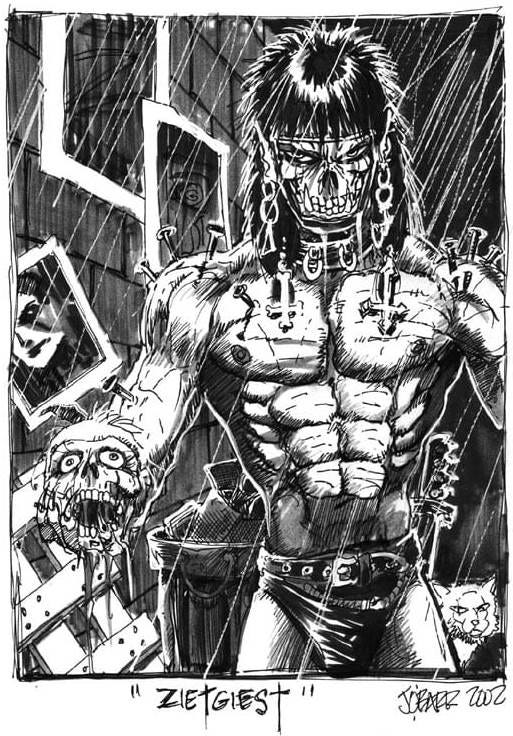
Crow Sequels, Kitchen Sink Era

After a few quiet years, O’Barr returned to his signature creation in 1996 — months ahead of The Crow: City of Angels movie — with a mini-series called The Crow: Dead Time from Kitchen Sink. O’Barr was credited with plotting the series, which was scripted by John Wagner (whose own graphic novel A History of Violence with O’Barr’s fellow Caliber alum Vince Locke was later adapted to film) and illustrated by Alex Maleev (who soon became a superstar at Marvel). O’Barr provided painted covers for the series, but instead of Dead Time’s main character (an Absarokan man who comes back from the dead in 1990s), his covers depict Eric.

O’Barr provided more topical covers for the second Kitchen Sink sequel series, Flesh and Blood, featuring Iris Shaw, the first series to feature a female Crow. He had little involvement to no involvement with the other sequels that followed in the 1990s and the ongoing series from Todd McFarlane’s imprint at Image Comics. The two notable exceptions were the covers for the first three issues of the Crow/Razor cross-over series published by London Night Studios and a three-page Crow gag story for Deady the Terrible Teddy vol. 2 in 2004.
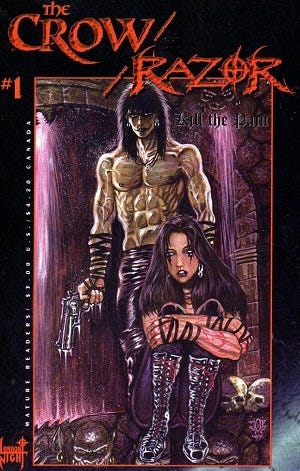
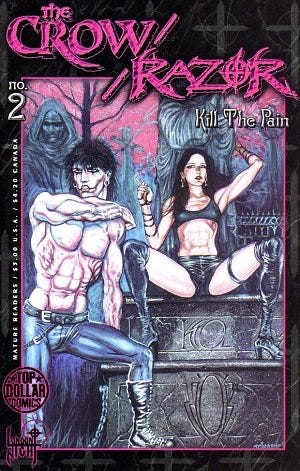
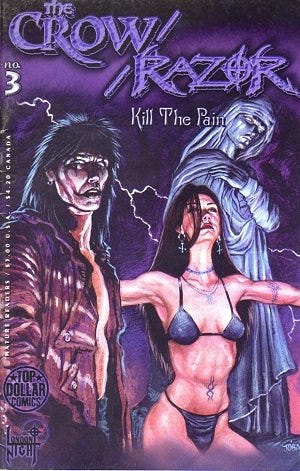

But there’s another unrealized Crow sequel that O’Barr has talked about many times. One of the earliest mentions is in Fangoria in 1996, where he describes a new Crow character for a Kitchen Sink mini-series:
“The character who comes back calls himself October because he can’t remember his real name,” O’Barr explains. “He’s a totally insane individual who doesn’t see the villains as real people but rather as monsters and demons.”

The Crow # 0, published by Kitchen Sink in 1998, included some preview art for October, which portrayed a male Crow character who looked much like Eric Draven along with a woman in a wedding dress. The Bride also appears in pin-ups in Pink Dust and Tasty Bits. The book was later referred to as Engines of Despair. O’Barr talked a little about the project in an interview with The Crow Magazine from 1999:
The Crow series I’m working on now deals with a female Crow. I’m definitely having a lot of fun with it [O’Barr later revealed that this new work will be a six-part story and will feature both a male and female Crow, although the plot will center more on the female Crow’s character.]
The website A Boy and His Bird reported from DragonCon 2000:
He is currently working on a Crow story that has a strong female lead as well as a male character. Neither character is as angelic as Eric and Shelly in the first story. The characters did not have such a great love life. They were not as “pure” as the characters in the first story. Along with retribution, we will also see the element of forgiveness that will have to happen between the two characters.
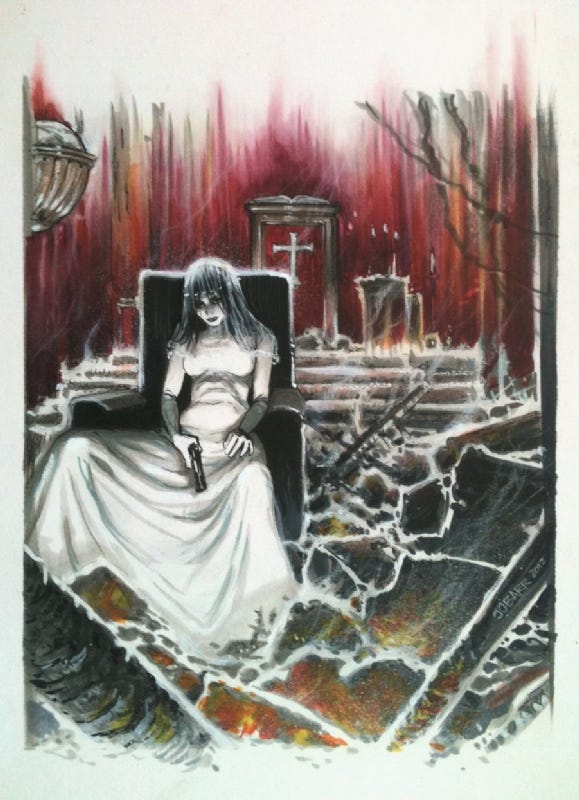
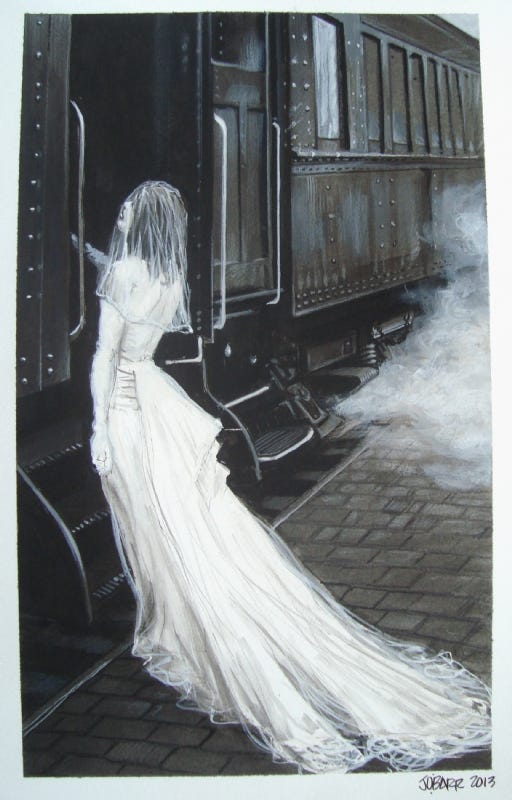
In more recent interviews he’s described the “Bride Crow” concept as having originated as a rejected treatment for a second or third Crow film, he told Fangoria in 1996 that he’d been asked to write a treatment for the second film but: “Even though I was working through a different character, he still embodied the same themes and emotional elements. I could only see Brandon in that light. So I declined to be involved.” That said, he did publish a Bride sketch on his old website that is signed 1997 and labeled “Crow II Treatment, Satan’s Grin/God’s Tears.” It’s possible that he started a treatment in 1996, combined The Bride idea with the October concept, and then tried again ahead of the third film.
O’Barr still talks about The Bride Crow comic as a work in progress in recent interviews.

Sundown in Hell

The Crow sequels likely pulled O’Barr’s focus away from Gothik and “Zeitgeist,” but he also worked on another project at the time. In 1996 Fangoria reported: “The Crow’s father also has his hands in a couple of other film projects. One is an as yet untitled “dirty and gritty” updating of The Count of Monte Cristo set in the present day. The other, an existential science fiction Western called Kerosene, chronicles the adventures of a 7-foot albino alien and an escaped slave as they make their way across the Old West.”
I haven’t come across any other mentions of The Count of Monte Cristo project, but Kerosene is likely the project that evolved into Sundown in Hell and later just Sundown. In 2000, O’Barr still described the story (then called Kerosene & Mr. Joe) as a film project. But by the 2004 Suicide Girls interview, it had become a comic book project:
Yeah, it’s called Sundown in Hell. I thought I would take two of my favorite genres and throw in two of my favorite actors to see what would happen. It started out as this fun kind of goofy gothic western thing. If Robert Mitchum and Joan Jett were vampires in the old west during the Civil War halfway through an Indian uprising. I thought it would be a great chance to do all these atmospheric western shots and a whole bunch of violence [laughs]. I didn’t realize how much research I was going to have to put into Civil War uniforms and weapons. People that are fans of that type of stuff are such nitpickers that if the insignia is wrong on some guy’s shoulder patch then I’m going to catch hell for it. So I have dozens of notebooks filled with reference material. It’s still a lot of fun and hasn’t lost the core meaning for me.”

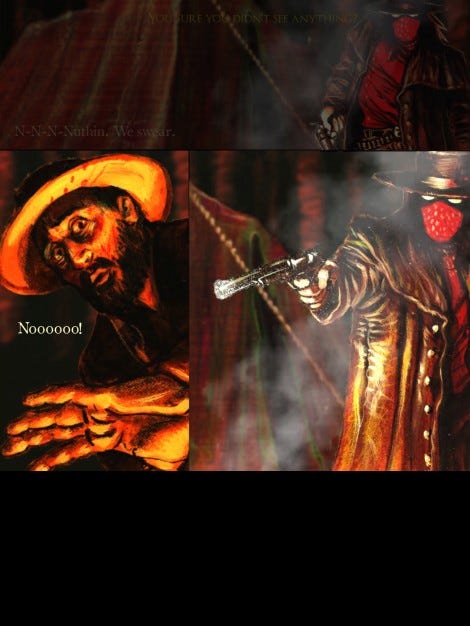
Part of this finally appeared in March, 2013 in the form of a “motion comic” app for the iPad from the apparently defunct, Dallas-based company MotionWorks Entertainment. “During a conversation I had with the creator of ‘The Crow’, James O’ Barr, I discovered that he had a project he was pitching to companies called ‘Sundown’, a gothic western,” former MotionWorks creative director Dublin Evans wrote on his (now defunct?) website. “With many discussions of over a year and a half sitting at a nearby coffee shop, we fine tuned the process to be primarily a ‘work of art’, originally hand painted and handcrafted; not digitally drawn, painted, or enhanced.” Evans left Motionworks shortly after the trailer, and it doesn’t look like MotionWorks is still an active company.
The app is no longer available, but you can still watch the trailer on YouTube. Forever Geek also published a fairly detailed review. [If anyone has a copy of this first chapter of Sundown in any format, please let me know, I didn’t find out about the app until it was too late.]

O’Barr has referred to Sundown as “Wizard of Oz if it had been directed by Sergio Leone.” I wonder if it might be an attempt to tell the story from Gothik as a western. Krait could be a stand-in for Blixa and Lucy for Gracie. However, O’Barr apparently started Sundown when Gothik was still a work in progress. Bergin described both Golgothika and Wednesday as cyberpunk versions of Wizard of Oz, so it seems that Oz is an important touchstone for the two and references to it shouldn’t be taken too literally.
O’Barr has continued to talk about Sundown as a work-in-progress in recent years.
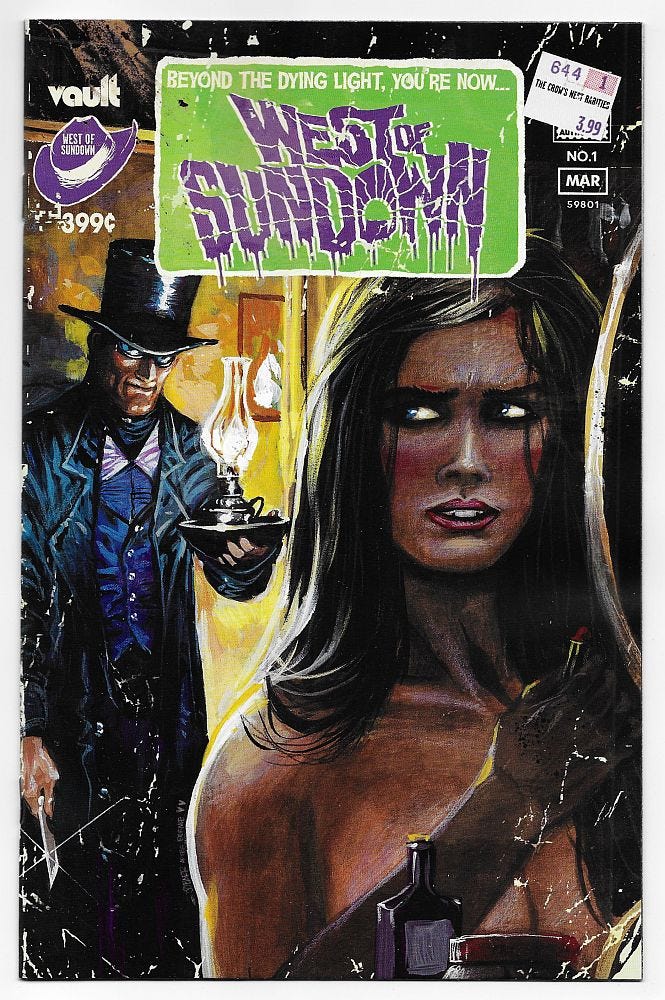
The Ride: Intertia’s Kiss

The 00s were another quiet period for O’Barr. He did the above-mentioned Deady gag strip, a few covers, and the reprint books mentioned below, but very little else surfaced from him during this time period. In 2004, he told Suicide Girls that he’d moved from Michigan to Los Angles with the intention of drawing storyboards for films and commercials, so that could account for the reduced output, though I haven’t been able to find out anything about any film or television projects he worked on at the time (though he did mention doing storyboards for what turned out to be a cyberpunk porn film during an interview with Mother Fucker in a Cape). He was also doing commissions and working the convention circuit at the time and releasing sketchbooks under his own Blue Monkey Publishing banner.

In June 2006, 12 Gauge Comics announced O’Barr would write and draw a story for the imprint’s flagship series, The Ride. Each The Ride story features a different creative team telling a different story with different characters about the same 1967 Camaro. Since the book's launch in 2004, creators like Ron Marz, Cully Hamner, Brian Stelfreeze, and Jason Pearson have all tried their hand at the concept. “12 Gauge is composed of people I like and admire and I’m happy to be counted among their pit-crew,” O’Barr said in a press release in 2006. “In such worthwhile company, I look forward to having my turn behind the wheel of THE RIDE, taking on the challenge of adding my own special brand of depth, poetry — and a whole bunch of violence — to what is essentially one long car chase. I’m having fun doing comics again and that’s what brings out my best work.”
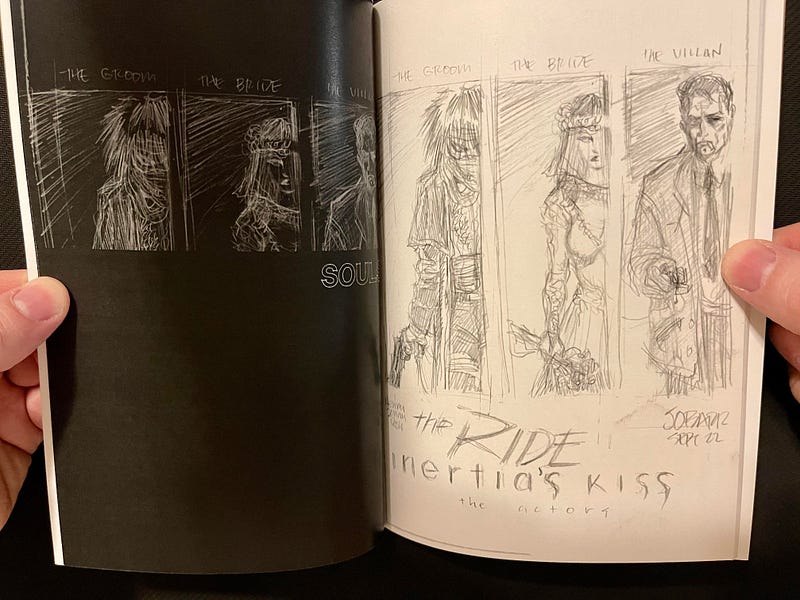
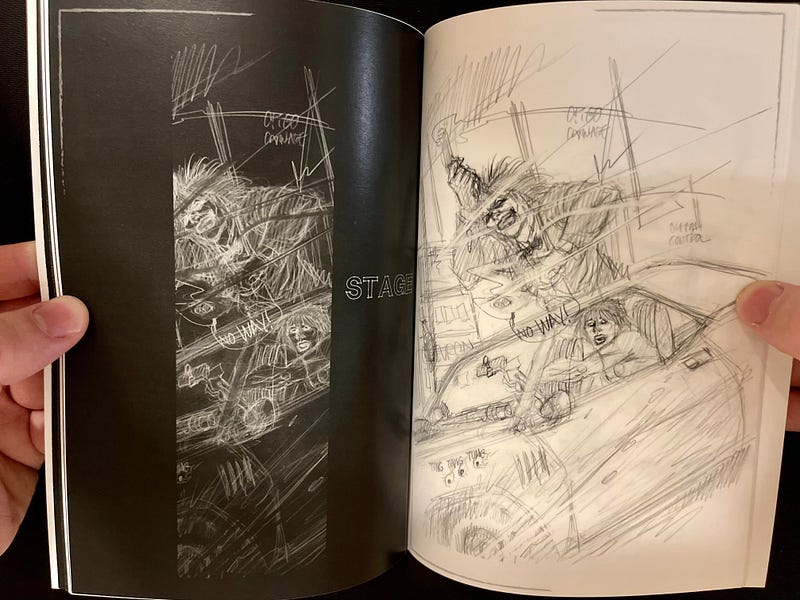
That summer 12 Gauge released a convention book called The Ride: Inertia’s Kiss Sketchbook. O’Barr’s story brought back Henry from “Slave Cylinder” but inserted him into a modern-day story involving Henry and his bride (echoes of Engines of Despair here) facing off against a John Mitchum look-alike shortly after their wedding (Mitchum is also the model for a character in Sundown). The book also reprinted “Slave Cylinder” and “G Forces” (from Savage Tales in 1986).
No more of the project has been published to date, possibly owing to “scope creep.” According to 12 Gauge Comics founder Keven Gardner, the project had originally been conceived as a single 22-page comic. But at Chicago Comic Con in 2009 O’Barr revealed that it be 90 to 100 pages — much to Gardner’s surprise!
From an interview at Wizard World Texas around the same time:
I’m working on a special or annual issue. There has never been a really good car chase scene in comics, and I thought that would be a nice challenge for me to do. But now I understand why there never has been one. It’s a static medium, and trying to make [the car] look like it’s going fast or going around a corner is really difficult. But I’m really happy with the pages I have so far. I set it in the ghetto at midnight in a snowstorm. I didn’t want to have just a flat surface with speed lines and vanishing points on horizon lines. I wanted levels and depth to the panels. There’s almost a 3-D effect to the artwork. When it’s finished it’s probably going to be about 96 pages. But it’s probably the best work I’ve done so far.
[Note: I saved a copy of the text of this interview, but I didn’t note the URL. The interview is no longer online and I’m not sure what year it’s from. If you know when it’s from or have an archive.org link please let me know.] At Chicago Comic Con in 2009, he said The Ride would be 90–100 pages.
O’Barr hasn’t spoken about this project in interviews for years.
[Note: If anyone has a copy of the sketchbook for sale I’d love to buy it]
Octane and Unnamed Project with Jason Alexander


Octane was another unrealized project, conceived for MotionWorks Entertainment at around the same time the company developed Sundown app (2011–2013). “While developing several projects at MWE, I had one pet project, a post-apocalyptic thriller,” Evans wrote on his website. “Later, James O’Barr gave it the name, ‘Octane’. I created the original concept and premise as Mad Max meets Dante’s Inferno. James and I collaborated on the story for over [a] year while he drew the opening sequence.” Evans cites O’Barr’s return to The Crow as the reason for the project’s demise.
In 2012, Bleeding Cool reported that O’Barr and Empty Zone artist Jason Alexander might “soon be working on a comic project together. It may not be announced this week, but you can start looking for it soon.” As far as I know, nothing ever came of this, though O’Barr did do a variant cover for Killadelphia # 16, which was illustrated by Alexander, in 2021. O’Barr might have been hoping to have Alexander do one of The Crow sequels at IDW.

Reprints and Covers
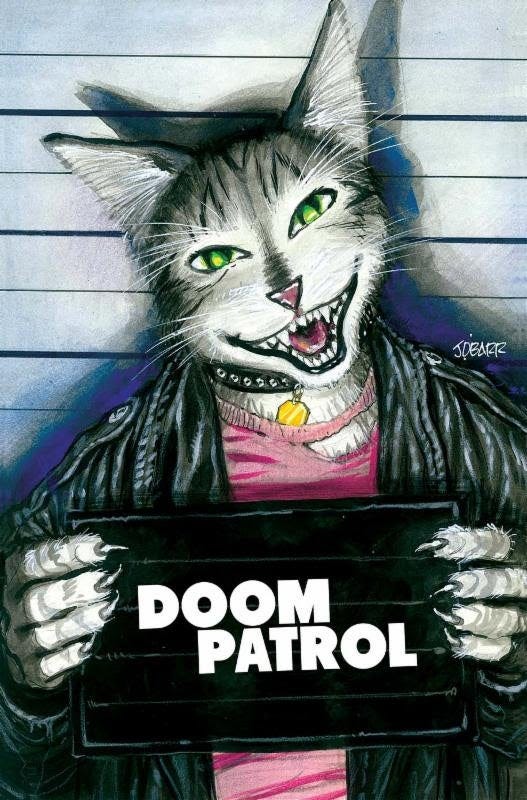

Even during O’Barr’s quiet years from the late 1990s to 2012, fans were treated to reprints, many of which contained previously unseen works. These included:
- Pink Dust, published in 1998 by Kitchen Sink, included a poem by O’Barr, illustrated with new art as well as a black-and-white reprint of “Slave Cylinder” and a few pin-ups.
- Tasty Bits, published in 1999 by ACG, featured a previously unseen story by a teenage O’Barr titled “Upon Thy Belly,” a previously unpublished silent story about a barbarian called “Shadows,” a reprint of “Frame 137” and lots of pin-ups.
- Original Sins, published in 1999 by ACG, featured an unused Black Chrome cover as its cover and reprinted “Io.”
- Savages, published in 2001 by Peregrine, reprinted “Shadows” and featured lots of previously unpublished pin-ups dating back to O’Barr’s youth.
- The Crow: Special Edition published by Simon and Shuster in 2011, featured several new pages drawn by O’Barr in a new style.

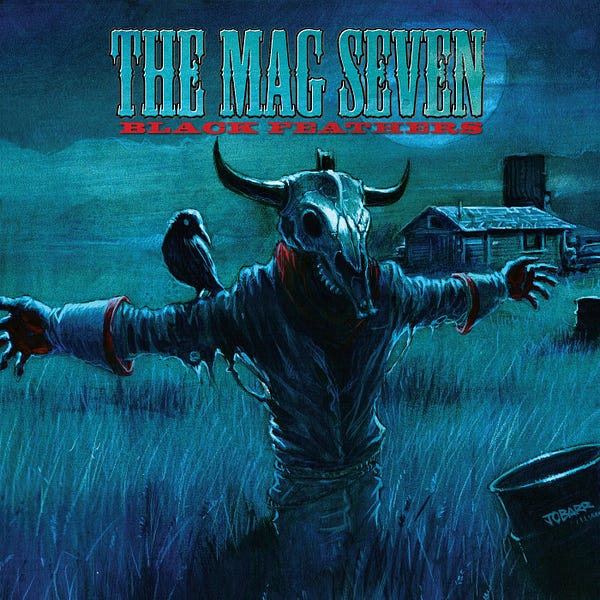

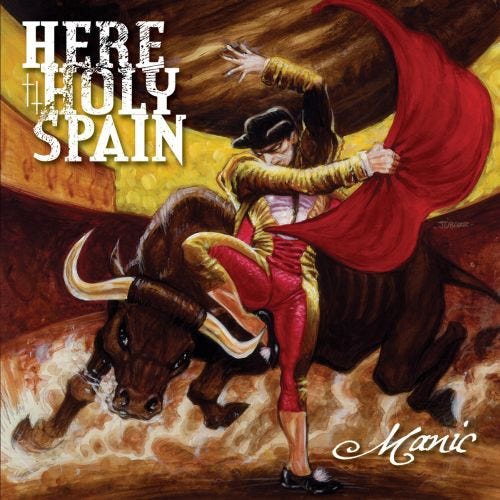
He’s also continued to do covers for many different projects, including album covers (for The Mag Seven; Here Holy Spain; Dance Hall Pimps; and These Machines Are Winning, for whom he also co-wrote a song), book covers (Beat to a Pulp, Mr Rhee), and comic book covers for titles such as Doom Patrol, Gideon Falls, Judge Dredd, Killadelphia, and most recently West of Sundown. John Ekleberry has compiled a massive checklist of O’Barr’s work, from The Crow to obscure pin-ups and backcovers.

Crow Sequels, The IDW Era

After several Crow-less years following the cancelation of the TV series in 1999, the end of the Image/McFarlane series that same year, and the disastrous fourth film Wicked Prayer in 2005, IDW acquired the comic book rights for The Crow and O’Barr returned to his signature creation. IDW kicked off a new series of mini-series in 2012 with a book titled simply The Crow (and reprinted as The Crow: Death and Rebirth) written by The Crow film screenplay co-author John Shirley with art by Kevin Colden and covers by O’Barr. Then O’Barr took a more active role. In 2012 he wrote and laid-out The Crow: Skinning The Wolves, with Jim Terry providing finished art. It told the tale of a Jewish concentration camp survivor returning to take revenge on the Nazis. O’Barr also wrote 2013’s The Crow: Curare, illustrated by Antoine Dodé, which brought a new spin to the series: a retired, alcoholic detective struggles to solve the brutal murder of a child decades after the event. He starts seeing visions of the murdered child and the iconic corvid. The apparitions aid his investigation (I believe this would make the girl the second female Crow).
O’Barr has been less involved in subsequent Crow books. He did covers for The Crow: Pestilence in 2014, but didn’t write or plot it, and he hasn’t even done covers for the newer mini-series. Still, this was the biggest period of new O’Barr work since the early 90s: the Sundown app (released in 2013), plus two whole mini-series written by the man — along with breakdowns for one of those series — is nothing to sneeze at.
His most recent contribution to The Crow legacy is a short story in the Italian translation of the IDW sequel The Crow: Memento Mori.

Other Works in Progress
In addition to Sundown, Engines of Despair (the “Bride Crow”), and a possible The Crow film reboot, O’Barr has talked about two other works-in-progress. One is a project he’s working on with his partner Chiara Bautista. Little has been said about what that might be yet. The other is about the Battle of Chosin Reservoir during the Korean War. It’s possible that the project with Bautista is part of the Chosin Reservoir project.
“Fox Company, 235 of them held a mountaintop in Korea for five days against thousands of well-armed Chinese troops in subzero temperatures. Unlike the Spartans, against all odds, they held the mountain, and 82 of them lived to tell the tale,” he told Korsgaard in 2014. “It’s one of the most heroic things I ever read, just the torturous conditions they fought under, against literally 20-to-1 odds, if I hadn’t read about it, I’d have thought it was unbelievable. […] There’s been thousands of films and hundreds and hundreds of comics about World War II, and about Vietnam, but Korea is really ‘the Forgotten War’, and in reality, there were just as many Medals of Honor handed out to Marines in Korea then there were in World War II or Vietnam, the conditions they faced were horrendous, the odds were overwhelming, it was a thankless job, and I want to do what I can to tell some of their stories.”
He went on to explain that the story will cover three different gun crews. “I’m going to write it, and I’m doing the art for one of the gun crews, and then two other artists will do the two other gun crews, and we’re going to switch back and forth between these different art styles, giving each gun crew their own personality,” he said. He’s mentioned Jim Terry (who drew The Crow: Skinning The Wolves and The Crow: Hack/Slash cross-over) as one of the illustrators.
Good Things Come to Those Who Wait
A few themes have emerged over the course of this article. One is a tendency for O’Barr to juggle multiple projects at once. This goes back to the beginning of his career at Caliber when, at one point, he was committed to drawing the ongoing Deadworld series as well as The Crow and IO. In the mid-90s he was working on Gothik, October, “Zeitgeist,” and two film projects. Today he’s working on at least three different comics projects, plus possibly a separate project with Bautista. Another is perfectionism: recall the attention to detail he’s been putting into Sundown and his reluctance to release Gothik because the technology is dated. A third is scope creep: Inertia’s Kiss went from 22 pages to around 100. Gothik also ballooned and it could be that Sundown has too.
But Skinning The Wolves and Curare show that he can still finish projects. Hopefully our patience will be rewarded soon.
James O’Barr Series
- Part 1: The Crow Creator James O’Barr’s Early Years
- Part 2: Caliber Comics (Forthcoming)
- Part 3: After The Crow: The Later Works of James O’Barr
If you want to follow this series, follow Sewer Mutant here on Medium, or subscribe to my email newsletter:
